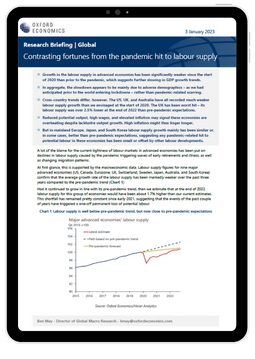Research Briefing
| Jan 3, 2023
Contrasting fortunes from the pandemic hit to labour supply

Growth in the labour supply in advanced economies has been significantly weaker since the start of 2020 than prior to the pandemic, which suggests further slowing in GDP growth trends.
What you will learn:
- In aggregate, the slowdown appears to be mainly due to adverse demographics – as we had anticipated prior to the world entering lockdowns – rather than pandemic-related scarring.
- Cross-country trends differ, however. The US, UK, and Australia have all recorded much weaker labour supply growth than we envisaged at the start of 2020. The UK has been worst hit – its labour supply was over 2.5% lower at the end of 2022 than pre-pandemic expectations.
- Reduced potential output, high wages, and elevated inflation may signal these economies are overheating despite lacklustre output growth. High inflation might thus linger longer.
Tags:
Related Services


Service
Global Economic Model
Our Global Economic Model provides a rigorous and consistent structure for forecasting and testing scenarios.
Find Out More
